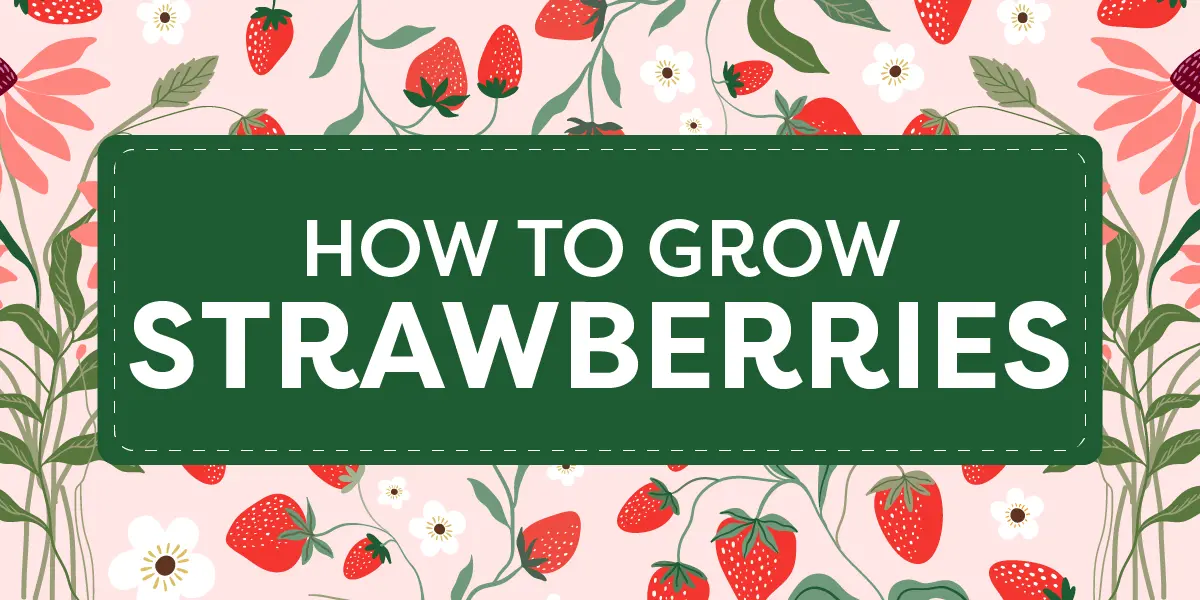What’s the best-selling jam in America?
Strawberry, of course. Strawberries are America’s sweetheart. Nothing compares to the luscious flavor of a sun-ripened strawberry straight from the garden.
And if you live in Southern California, you’re in a prime region for strawberry cultivation. The climate and soil conditions are ideal for growing the delectable berries.
Even if you don’t have access to a garden plot, nothing’s stopping you from planting a container crop on a back porch or balcony.
So how do you get started? Here, we’ll share our top tips to grow sweet, juicy strawberries for a bounty of fresh fruit.
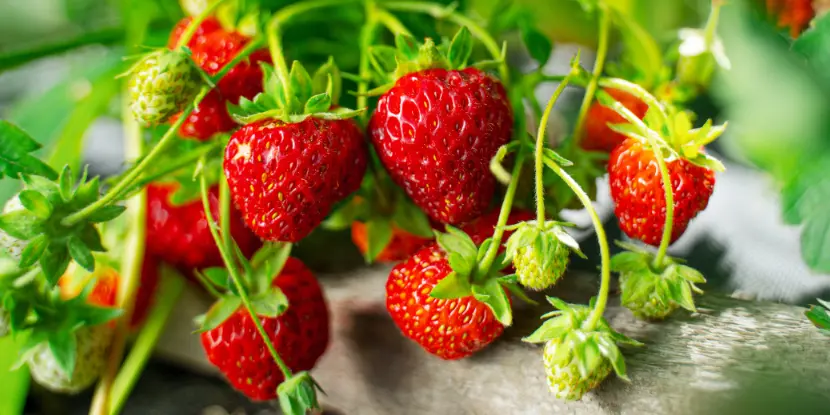
Ripe strawberries ready for harvest.
Selecting the Right Variety
Growing Strawberries from Seedlings
Local nurseries, like the Anawalt Garden Center, carry an assortment of California-bred varieties, like ‘Albion,’ ‘Seascape,’ ‘Festival,’ and ‘San Andreas.’
These are all day-neutral or ever bearing types, meaning they produce fruit from late spring to fall and even into winter in frost-free areas.
- Ever bearing vs. June-bearing: Choose strawberries that produce one large crop in early summer (June-bearing) or those that yield multiple smaller crops throughout the growing season (everbearing).
- Day-Neutral Varieties: These are often preferred because they produce fruit consistently throughout the year, regardless of day length.
- Heat Tolerance: The warm Southern California climate can be challenging for some types of strawberries. Look for heat-tolerant varieties.
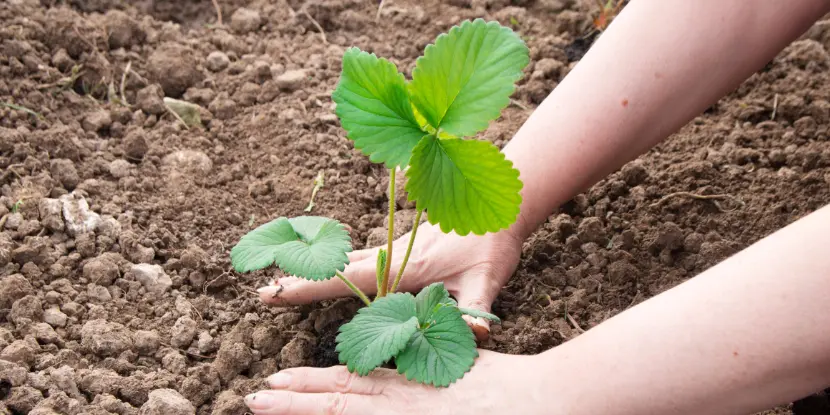
Planting a strawberry plant in the garden.
Growing Strawberries from Seeds
Cultivating strawberry plants from seeds presents distinct challenges compared to using seedlings:
- Time-Consuming Process: Germination can be slow, and seeds may take several weeks to sprout. After germination, strawberries grown from seeds require additional time — sometimes over a year — before they’re mature enough to produce fruit.
- Specific Requirements: The seeds should be started indoors in a controlled environment, usually in late winter to early spring. They need a well-draining soil mix, consistent moisture, and plenty of light, all of which require careful attention and maintenance.
- Variety and Quality Concerns: The online market is flooded with sellers offering strawberry seeds, but not all are trustworthy. Some may sell mislabeled varieties or seeds with low germination rates. Beware of seeds for unusual or exotic strawberry varieties that seem too good to be true — they often are.
Preparing Your Soil
Now, it’s time to prepare the soil for planting. Here’s how to get it in tip-top shape:
- Choose a Sunny Spot: Strawberries love sunshine, so pick a location in your garden with at least 6–8 hours of sunlight daily.
- Test Your Soil: Use a soil test kit to determine your soil’s pH and nutrient levels. Strawberries prefer slightly acidic soil with a pH between 5.5 and 6.5.
- Amend as Needed: If your soil pH is too high, add sulfur to lower it. If it’s too low, incorporate lime to raise it. Mix in compost or aged manure to improve soil structure and fertility.
- Use Raised Beds or Containers: If your soil is poor, or you have limited space, consider growing strawberries in raised beds or containers filled with high-quality potting mix.
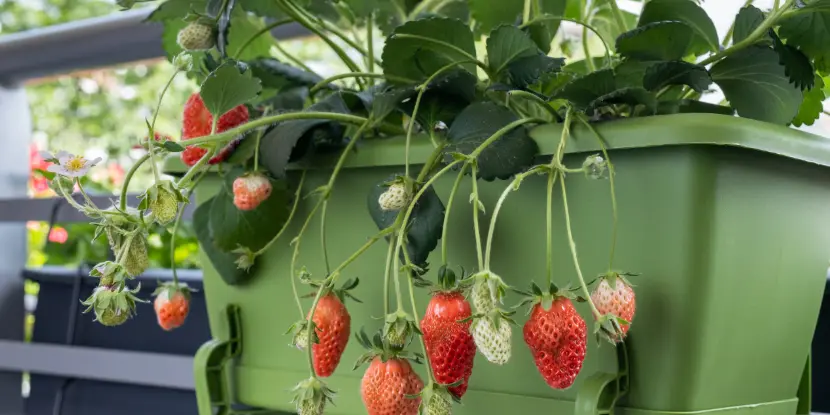
Container-grown strawberries.
Planting Your Strawberries
- Spacing: Space your strawberry plants 12–18 inches apart to allow proper airflow and growth.
- Planting Depth: Dig holes slightly deeper than the roots of your strawberry plants and place them in the ground or containers, ensuring the crown (where the roots meet the leaves) is level with the soil surface.
- Watering: After planting, give your strawberry plants a generous drink of water to help them settle into their new home.
- Mulching: Apply a layer of mulch around your strawberry plants to help retain moisture, suppress weeds, and keep the fruit clean.
Caring for Your Strawberry Plants
- Watering: Keep your strawberry plants moist, especially during hot weather. Water deeply to encourage deep root growth.
- Fertilizing: Feed your strawberry plants a balanced fertilizer every 4-6 weeks during the growing season to promote healthy growth and fruit production.
- Thinning: As strawberry plants grow, prune excess runners to prevent overcrowding and encourage larger fruit production.
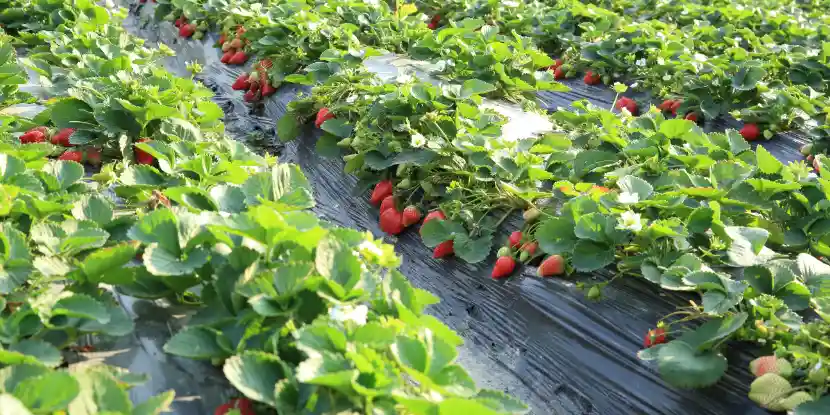
Strawberry plants protected by plastic sheets to retain soil moisture.
Pest & Disease Control
California’s most common pests and diseases are aphids, spider mites, slugs, and fungal infections like powdery mildew and gray mold (botrytis). These nuisances hamper the plant’s growth and severely affect the fruit’s quantity and quality.
Natural Pest Control Methods
- Aphids and Spider Mites: Introduce beneficial insects like ladybugs and lacewings into your garden. These natural predators feast on aphids and mites.
- Slugs: Handpick slugs during the evening or set up beer traps to attract and drown them. Diatomaceous earth or crushed eggshells spread around plants can deter slugs from crossing over to your plants.
- Birds and Rats: Protect your crops by covering them with netting or floating row covers.

Strawberries grown in hanging pots.
Natural Disease Control Methods
- Powdery Mildew: Ensure good air circulation around your plants. Don’t overcrowd them. Apply neem oil or a mixture of baking soda and water as a foliar spray to prevent or treat mildew infections.
- Gray Mold (Botrytis): Reduce humidity around your strawberry plants by watering them early in the morning and using drip irrigation instead of overhead watering. Remove any infected parts promptly and dispose of them far from your garden to prevent the spread of spores. Trichoderma harzianum, a beneficial fungus, can be introduced to the soil to combat gray mold.
When to Replace Strawberry Plants
In California, strawberry plants can be productive and bear fruit for about 3 to 5 years. However, we recommend replacing strawberry plants every 2 to 3 years for optimal fruit production.
Plants can become less vigorous and more susceptible to pests and diseases over time, significantly affecting yield. You ensure a consistent, high-quality harvest by regularly refreshing your strawberry patch with new plants.
Plant your strawberries in a different location each time to minimize disease buildup and maintain soil health.

Planting a strawberry plant in a clay pot.
Companion Planting for Strawberries
Companion planting is the practice of growing crops or flowers in proximity for mutual support.
It’s a technique gardeners have used for centuries to maximize their yields and create a more sustainable ecosystem.
Strawberries benefit from the nutrients certain companion plants provide, while other companion plants can repel pests, reducing the need for pesticides.
Some of the best companion plants for strawberries include:
FAQs: Growing Strawberries
Q: Can I grow strawberries in containers?
Growing strawberries in containers is an excellent option for small spaces or poor soil conditions. Always use a high-quality potting mix and provide adequate drainage.
Q: How often should I water my strawberry plants?
Strawberry plants prefer moist soil, so water them regularly, especially during hot weather. Check the soil moisture frequently, and adjust your watering schedule as needed.
Q: Do I need to cover my strawberry plants during cold weather?
Your plants may need frost protection during occasional cold snaps in Southern California. Cover your strawberry plants with frost cloth or blankets during freezing temperatures.
Q: What is the best time of year to plant strawberries in California?
The best time to plant ranges from late fall to early spring. This allows the plants to establish themselves and take advantage of the mild winter and spring weather for growth before the heat of summer sets in.
Q: Can strawberries be grown year-round in California?
In some parts of California, particularly the coastal areas with milder climates, it’s possible to grow strawberries year-round. However, most gardeners find spring planting best for a single, concentrated harvest.
Q: What type of strawberry plants are best suited for California’s climate?
Day-neutral and everbearing varieties perform well in California because they produce fruit throughout various parts of the growing season. Popular varieties include ‘Albion,’ ‘Seascape,’ and ‘San Andreas.’
Q: How can I protect my strawberry plants from birds and other pests?
Using bird netting or floating row covers can protect strawberry plants from birds, insects, and other small animals. Installing these barriers early in the season can prevent pests from discovering your plants.
Q: How do I manage weeds around my strawberry plants?
Mulching around strawberry plants with straw, pine needles, or black plastic can help suppress weeds, retain soil moisture, and keep fruit clean. Hand weeding is also effective, but be careful not to disturb the strawberry plants’ roots.
Q: What are the signs my strawberry plant isn’t healthy?
Signs of distress include yellowing leaves, stunted growth, wilting despite adequate watering, and the presence of mold or fungus on the fruit or leaves. These symptoms could indicate disease or pest issues.
Q: How often should I replace my strawberry plants?
Although strawberry plants can produce fruit for several years, productivity often diminishes after the second or third year. Replacing your plants every 3-4 years can maintain a high yield.

